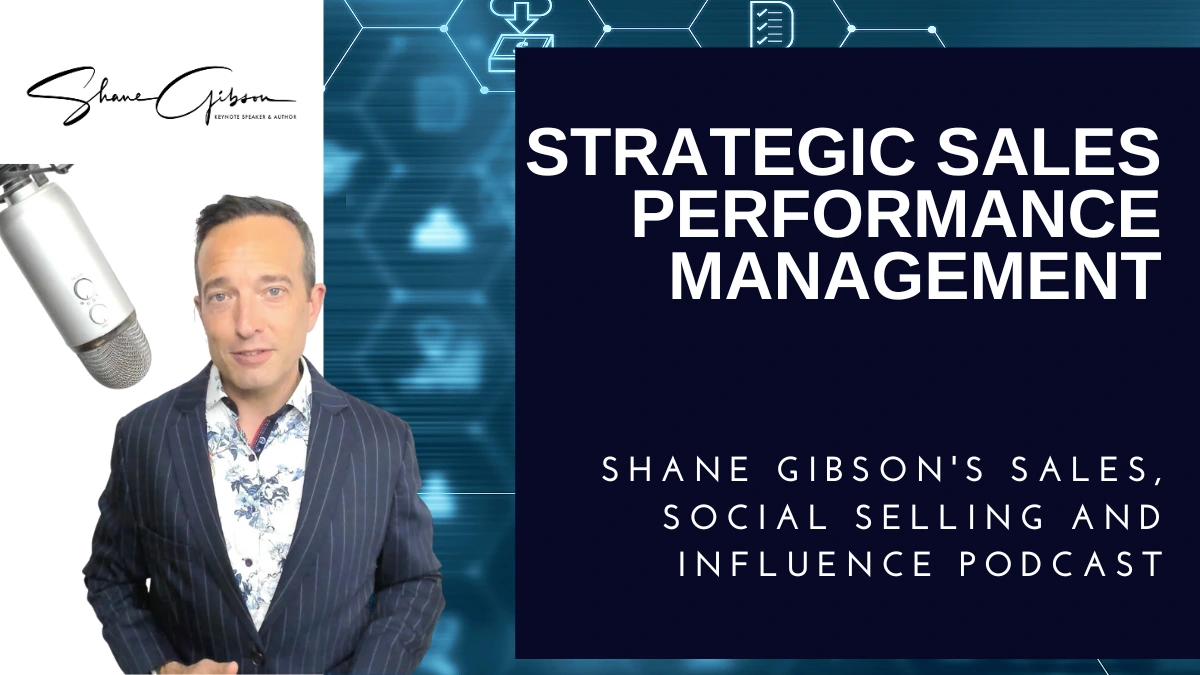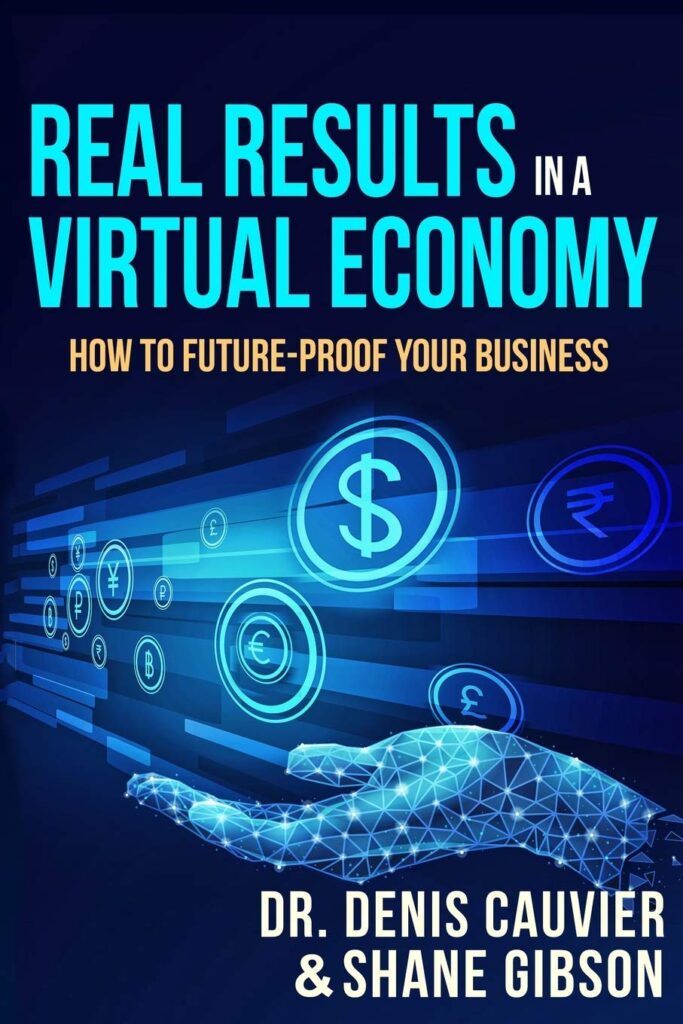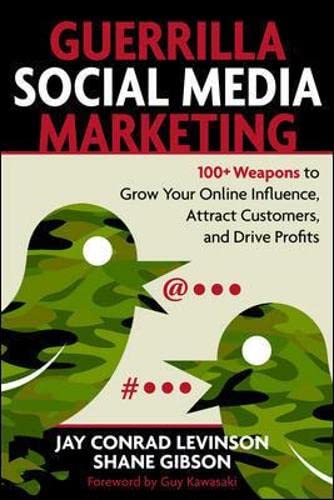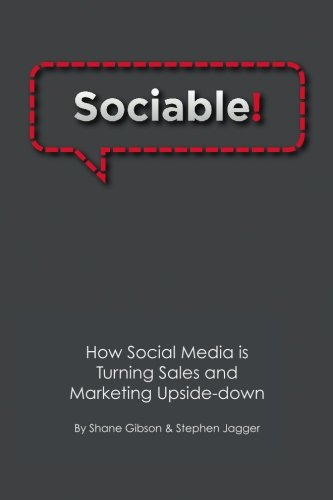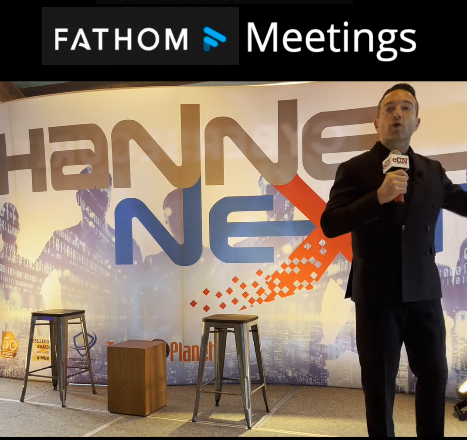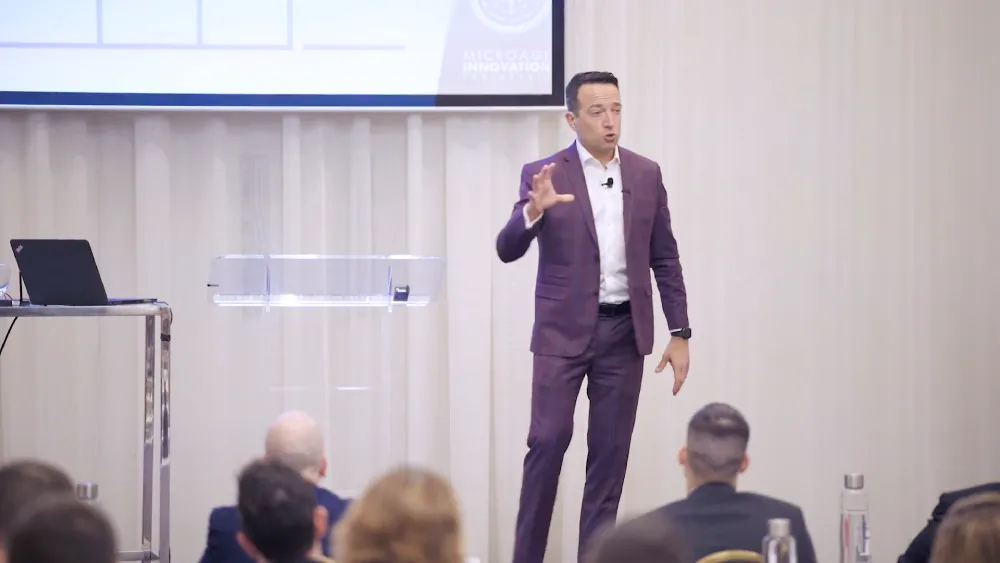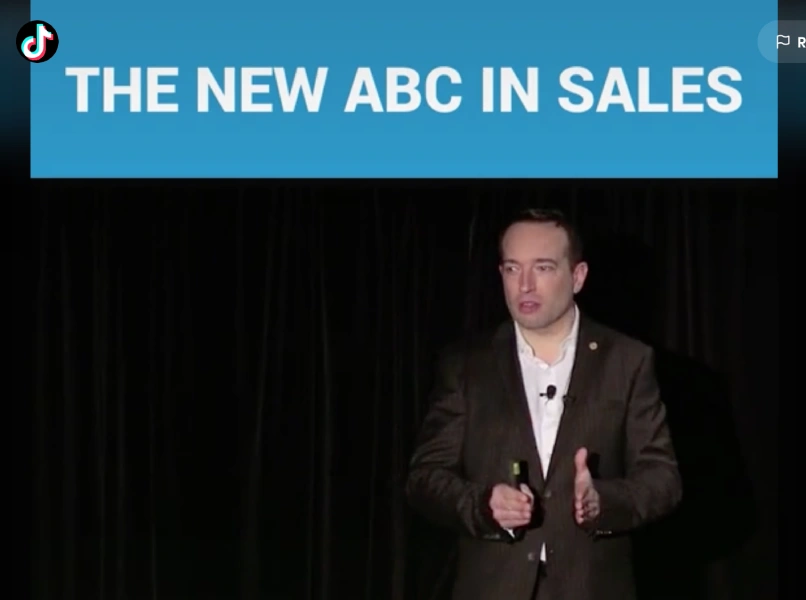Sales Podcast – Strategic Sales Performance Management
Podcast: Play in new window | Download | Embed
Subscribe: RSS
This sales podcast episode is focused on shifting our sales performance management from tactical to strategic. Although there are dozens of strategic shifts we can make, today we are focused on three key levers that can impact your personal and organizational sales performance.
Below you will find the video version of the podcast and an abridged version of the transcript. If you’re looking for a keynote sales speaker for your next sales conference you can contact us to book a quick discovery call.
Sales Podcast – Keynote Sales Speaker Shane Gibson on Strategic Sales Performance
[transcript begins]
Transcript:
I want to talk about strategic sales performance improvement today. Many of our sales performance improvements come down to tactics—slight shifts in interactions or key steps in our sales process. When I think of non-strategic sales performance improvement, I think of merely improving or increasing the numbers.
Instead of focusing on numbers, orders, or specific tactics, I want to delve into how we can impact performance improvement within our sales team, ourselves, or individual salespeople by emphasizing a shift in our strategic thinking. I’ve identified three levers that can alter the way we think or approach the marketplace and consistently impact our overall sales performance. While in many cases we’re thinking tactically, I want us to transition into strategy.
Strategy can also be influenced by tactics. For instance, if your organization aims to focus on larger accounts or more intricate, profitable deals, yet our salespeople still employ tactics suitable for the small to medium-sized industry, we won’t achieve our strategic result. This discrepancy shows how tactics can sometimes drive strategy. If we find ourselves able to close specific types of accounts due to the responsiveness of our marketing and sales processes, it might seem like that’s our ideal market. But often, it’s our tactics which target a specific segment.
So, when we strategically consider new targets or opportunities or evolve our external perspective on clientele and brand, it’s vital to ensure our sales tactics align with our sales strategy shift.
The three sales performance management levers I’ll focus on today are:
- Business acumen building: What does a robust business acumen building system look like? Building acumen in our sales team can be a pivotal strategic shift in our sales performance.
- A-Zone Pipeline Management: Those familiar with my seminars or podcasts know I discuss the A-zone or the 80-20 rule frequently. Here, I’ll delve deeper into how we can strategically approach our pipeline with an A-focused mindset and its effects on our sales productivity and performance.
- In-between meetings: One area to enhance our performance, pipeline, referrals, deal size, and renewals is by systematizing and emphasizing what I term “in-between meetings”. These are value-added interactions over time with key accounts outside of and amidst the essential steps in the sales process.
Building Business Acumen in Your Sales Team:
Discussing the first lever—acumen developing system—what is a system? A system encompasses a process, methodology, technology, and accountability. A reliable system has a clear process, robust methodology for each step, is technologically driven, and incorporates accountability to ensure each step is executed correctly. Acumen is often the missing ingredient for potential value sellers and trusted advisors. If my client possesses vast industry knowledge and I only understand the basics, how can I add value to our conversation? It’s nearly impossible. Building acumen is crucial to execute most modern sales strategies. These strategies center around transitioning salespeople from mere order-takers to valuable partners for clients, a shift that can’t happen without honing business acumen.
Too many salespeople believe they need more leads, and often, sales management assumes we need more leads in the funnel. However, the real issue may be the inability to convert, not the lack of leads. A significant cause of this problem can be a lack of business acumen, leading to reduced credibility in customer conversations. Thus, building our business acumen is a continuous process, not a one-time event. It’s not about just learning about our company’s products or market but making acumen building an integral and ongoing part of our process.
So when I think about business acumen, let’s start even with discovery conversations. Number one, before I start picking up the phone or reaching out to clients, do I know our key market segments? And then, do I know their business, their clients, their industry, and their market intimately? As a sales professional, do I understand their top five to ten goals, challenges, and hurdles? And that is of the typical client in my industry. I’m going to drill down through conversation and find them specific to that client.
But let’s say I’m focusing on the telecommunications industry for small to mid-sized telecom companies throughout the United States. For those types of companies, what are the typical five to ten major goals, challenges, and hurdles they’re facing right now in the marketplace? And then, do I know how we solve those challenges uniquely or which of those challenges we solve better than anybody else in the marketplace? So, do I know this? Have I spent time to educate myself? Have I, as a sales leader (and we’ll talk about how to do this later on), provided my team with the insights, resources, and tools to discover these things? And helped them develop the principles and expectations that they’re continually educating themselves as sales professionals around this?
The key, once you know all these things, for me, when I’m doing discovery conversations or meetings, is I want to build questions that unearth those top five to ten things that we can impact in a unique, powerful, and competitive way. So, I’m going to do a needs analysis or discovery meeting. I’m going to ask some of the typical questions a salesperson asks, but not too many.
What I really want to do is focus on asking the questions that unearth those drivers. I’m also going to be continually looking for industry authorities and really geek out on trends, technology, news, and advancements on a regular basis. So, great salespeople today, I believe, are great students of their client, their industry, and their marketplace who self-educate on a nearly daily basis. And that’s how you move from being a four out of ten in knowledge trying to sell to a nine out of ten, to a peer or above who’s specialized in industry insights and knowledge.
So how do we do this? I’m going to give you a real quick shopping list of all the ways that you, as an individual salesperson or as a sales leader, want to put together for your team.
Number one, industry and persona-specific training for our team. I have a client that sells assessment tools into specific industries. One of the things they do with new salespeople is they actually get those salespeople to go through fundamental training around how to be successful in the role of their customer. So, if you were selling into, let’s say, a service manager at a car dealership, they would actually put you through a training program on Service Manager 101. Why? So that you can see through their eyes, have true empathy, and understand not just my product and how it benefits them but understand holistically the day in the life of our ideal decision-maker within our ideal client. Then, our overall business or industry ongoing education. So, do we have that set up? We should have a series of resources, conferences, webinars, you name it, that they can access.
Then, what I’d suggest, something a couple of my clients do, is they hold a state of the industry or region stand-up meeting once a week. Each person on the sales team is responsible for sharing new insights they’ve garnered in the marketplace. It could be shifts from a competitive perspective, regulations, marketplace changes, or consumer shifts—anything that impacts their customer. This includes attending conferences, reading industry magazines and portals, and, at the end of the day, getting to know our clients intimately.
One of the best ways to figure out how your solution impacts your clients positively is to sit down with your happy clients who’ve implemented your solutions long after you’ve closed the deal.
We do this by having client focus and use case meetings. One of the best ways to figure out how your solution impacts your clients positively is to sit down with your happy clients who’ve implemented your solutions long after you’ve closed the deal. Interview them to understand how they’re using your solution, how it’s impacted them, and what you could do better. By doing this regularly with our key accounts, we start to understand and collect great case studies and stories that we can use in our sales process later on.
Listen to calls of other team members, have lunches with our internal team members and experts. As a salesperson, if I’m selling technology for my company, when was the last time the sales team had lunch with the CTO and their product development team to discuss what they’re seeing in the marketplace and what they’re working on and why? This helps in developing a real intimate understanding of your product and your solutions and where it’s evolving to. Additionally, maintain a list of must-follow industry leaders. As a sales leader, do I have a top ten or top five list of industry leaders that my salespeople should follow regularly?
Systemizing Business Acumen Development
So how do I build an Acumen system out of this? First, how do you take this from a great idea to systematizing it, making it part of your training and development?
- Know your knowledge and competency map. What do your people need to know? What do they need to be experts in and learn continually?
- Quiz them on industry knowledge. You can do this formally and informally, through written quizzes, questioning them in stand-up meetings, or even role plays to see how well they use industry insights in a sales scenario.
- Listen to their calls and meetings, check for the application of principles, and even have a scorecard or at least a checklist they need to handle.
- What are the things they really need to know and check in on a regular basis with them and then make it a KPI or key performance indicator. Then make it part of their compensation and progression plan where they need to stay updated and continually educate themselves.
So why do this? And as a salesperson, if you’re listening to this going, “that’s a lot of pressure on me here”, and do I really want my management leaning on me with my acumen?
They’re doing you a favor! If you can expand your knowledge, become an expert, and a true resource to your client everything from prospecting to opportunity and development to networking, to your discovery calls, to your demos, to your ability to take what they’ve told you and show them why your solution can impact their business in a way that makes them want to do business with you all happen from building that business acumen. So that’s the big one, that’s lever one. And they’re all built upon this in my opinion.
AZone Pipeline Management
The second lever, which I’m not going to spend as much time on here, is the AZone Pipeline management. So we look at our entire pipeline, a lot of times it goes, “how much money or deals is in your sales pipeline?” And I say, “well, I’ve got a million dollars in there potential business.” But then when I start to look at, let’s take a look at everybody who stalled or hasn’t moved in the pipeline, and you kind of shave those off, and you look at who is progressing and moving on, and I’m staying engaged with on a regular basis. That’s a bit more of a realistic look on who’s really in our pipeline. In many cases, some of them are just stuck and they’re going to stay there forever or fall out.
But then on the next level is what’s our strategic pipeline? When I think of strategic pipeline, when I’m really looking at what’s the likely value of this pipeline, one of the biggest indicators for me isn’t the number of dollars, it’s the number of A category opportunities and the dollars associated with them. So our A’s, of course, are 20 percenters. They give us 80% of our business. We should understand who those are within our CRM but also within the marketplace.
And I want to know, if I’m managing performance, I want to actually look at focusing on the A’s. And that means how many do we add on a monthly basis to our pipeline, that salesperson? How many A’s have you taken from a suspect to a prospect to at least booking a first meeting with them? How many have you added to the pipeline at that stage? And then how many have we moved through a fulcrum step?
Your fulcrum sales step in your pipeline
And what I mean by a fulcrum step is depending upon your organization, you’ll have a certain step in your sales process where things begin to flow. So in my business, almost always a fulcrum step is the needs analysis. If I get a client on the phone for a discovery call, if it’s a deal, if there’s a match, if they’re a true A, there’s a high likelihood it’s going to move forward. So that’s a fulcrum step. So how many people have I moved through that step now? For a client of mine it doesn’t matter how many of those beautiful discovery meetings, where we are happy and things seem like they’re going to go well happen – For them, it’s actually the number of quotes and proposals they ship on a monthly basis. That’s their key performance indicator that they can tell in X weeks they’re going to have revenues on the board. So I would look at those two KPIs only and really work as a team to focus on them: how many A’s were adding and how many were moving through that fulcrum step, not how many deals, not how many C’s and B’s, not how many kind of truly not qualified prospects, but the true A’s. And that will give you a better idea from a forecasting perspective.
Now. Why A’s? For me, an A doesn’t mean the biggest prospect, it means one that truly is ideal. You’re ideal for them as a supplier, and they’re ideal for you as a client. This is a truly good fit. And when you find those types of clients, number one, they convert more often, they convert quicker, it’s easier to drive customer success and success stories, they’re easier to maintain. And almost always, a happy A who’s ideal for you is also often our best referral source. So it has this knock-on effect that ah, not only are they larger and more profitable deals in most cases, but they convert more often and quicker and they also precipitate into better referrals and less stress on our customer service system or our actual delivery side of our business, whatever solution we’re selling.
So how do we strategic and tactical with implementing this one performance improvement piece?
- Define our A’s: understanding who our true A category prospects and clients are.
- Invest in acumen around those specific A segments. So it’s not about knowing the whole marketplace but becoming an expert in our A category prospects, their clients, their target market.
- Lock in our calendar from a time perspective, a proper amount of time to actually go after these accounts. I’ve talked about this before, but for me, I think 25% or more time from a conquest perspective should be in our schedule on a weekly basis, but also not just time.
- Time blocking is important, but allocation of resources. So what I mean by this is that what resources do I need to allocate as a sales leader? What resources do I need to lobby upper management or the marketing team or production or whoever it might be to support the sales team in actually selling to these A’s? Is it getting them to the right events? Is it giving them more resources from a marketing perspective? Is it getting a sales admin person to help the team, a full-time researcher, whatever that might be, what resources they need to focus strategically, and then compensate more for A’s.
- I would look at even within my performance management from a rewards perspective. It’s great that they brought in a million dollars of revenues, but a certain percentage of it has to be conquest or new business. And within that, a certain percentage should be A accounts based upon the definition you give them. They get a bit of a top-up or additional bonus for focusing on our ideal client that fits where we want our business model to go.
- And lastly, fine tune collateral budgets and mentorship on this segment. So that’s the second big lever.
In-Between Meetings
So the in between meetings, this is the last one, and this kind of piggybacks on the first two is that many deals are closed and decisions are made outside of the sales or buyer steps in informal meetings, sidebar conversations, the meeting after the meeting, or even bumping into someone accidentally on purpose in the community or an organizational event. Relationships take more effort and frequent engagements than most sales processes allow or need.
So you’re in between key steps of the deal. You’ve got everything. Now there’s this sort of radio silence for a month. what are we doing to fill that silence? Sometimes it’s the in between meetings. It’s value added, just nurturing. But even after a deal is closed and they’re going to buy from us again a year from now or six months from now, are we leaving it till month five? Or do we have in between meetings or value added interactions that actually help increase our mind share, therefore our wallet share and expand the relationship.
When you have meetings that are outside of the typical sales process, you’re actually allowed to or you’re able to practice deep listening without an agenda and build trust. Also, space changes context, mood, and relationship dynamics. So what I mean by this is often in the sales process, maybe I’m always on a zoom call with them and it’s timed and it’s my sort of very this brick background behind me. And from this perspective, there’s not a lot to go on here. There’s no warm fuzzies we get out of this.
What happens if I can take that same client and just let them know I’m going to be in their area, and do they mind if I pop in for 20 minutes and say hello or invite them out for lunch or a coffee or to an event? These types of things where I can move someone out of the office space or a formal, rigid environment and into a more casual, relaxed atmosphere, actually can change the dynamic in the relationship.
One of the things I’ll do is if there’s major events in town occurring that I feel my clients would find valuable, I buy a ticket for myself, but I always buy an extra ticket. Invite out a key client who I know is open to maybe expanding the relationship, and that there would be value in building a relationship for both of us. And I often bring them to event with me. So I never go to event alone, if at all possible.
But many times those in between meetings, those conversations, the casual ones, actually help me understand them better and what motivates them in life and their business. And it really just makes it easier to grow the account, retain the account. And actually, for me, as a sales professional, it makes it more worthwhile. actually people like to do business with people who they like. And that goes for the seller too. I get to know people, I enjoy them, and it just makes it easier and my work more value added as well.
So make it part of your activities. So invite clients to lunch on a frequent basis. Actually set a goal or a KPI for that. How many of my key accounts or potential key accounts am I inviting out on a monthly or weekly basis? Maybe suggesting a meet up between steps of a long sales cycle to review notes, check in, confirm things haven’t changed, make sure that we’re on the right path.
Do an after sales service audit. So this is something we can do, I mentioned this earlier is set a goal that with each account at certain milestones after you’ve sold them, that the salesperson checks in with them again. Even if there’s a Customer Success Team, I think it’s important the salesperson that started the relationship originally does this. Because that’s going to drive maybe a different perspective. Maybe they’ll get some different information than the Customer Success Team gets. They want to share that, of course, but also what it also does in many cases is it plants the seed for referral business as well.
Attend industry events where you can bump into them. So this is another way that you can kind of manufacture these sidebar or informal conversations is making sure you’re out at industry and community events where your key accounts or key prospects are on a regular basis. Engage them on social media often. So you know that I’m a big advocate of social selling and these little casual, quick conversations or messages that we send to people or we congratulate people on stuff and we ask them key questions sometimes that can actually precipitate into a deeper conversation and a really valid reason to pick up the phone and say hello.
And then of course, participate in client events if they’re doing things in the community, if they’re holding festivals and conferences and trade shows, if the CEO is invited to speak at another conference, find a way to be there to engage them and meet their team. And again, create some more in between casual but vital meetings with your key accounts.
Manage these in between meetings by measuring it as part of your cadence. Give people a time and money budget they must spend on A’s. So this is important. Like, here’s your budget from a time perspective. I expect you to be spending 25% of, your proactive time on A’s. In addition to this, here’s your budget per A that you should be spending from a dollar perspective on entertaining them. Lunches, value added interactions, you name it.
And then make a list of gifts, value added tools, meeting types your team can use to engage sort of less formally and have a pre meeting question sheet built. Or at least get them in the habit of pre planning these get togethers so that although it’s a casual meeting, are there two or three key questions I’m going to ask that key account or client that might move the conversation in a certain direction?
So here’s the summary for our sales podcast today:
- Strategic improvement is not just about improving our activities or tactics, but changing the way we think. And so this podcast is really devoted to thinking like a business person and being strategic about who we engage in, deepening those relationships, but not just as a principle, but developing habits and processes and measurements and rewards around that new thinking. So it’s really about investing, becoming more valuable and credible. That’s about tracking education and it’s application with your team. Making sure that they’re continually educating themselves and that you’ve given them the tools to improve their business acumen continually.
- Switch your focus to your A pipeline. So yeah, you might have a million or 2 million in the pipeline as a salesperson but how many of those are a’s and how many of them have you been in touch with on a regular basis? And this will give us a better idea of our true value of our pipeline. And we switch our focus also by prioritizing time, resources and building that Acumen on our A’s.
- And lastly, we want to establish a deep relationship and better positioning through in between meetings by making them part of our process. So versus a nice to have or an afterthought. With my key accounts and my CRM, I actually want to schedule and look for opportunities to put in between meetings in the calendar. This will allow me to shift from pitch artist to value added and trusted advisor.
[end transcript]

